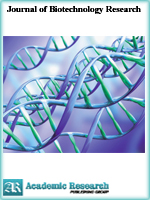Journal of Biotechnology Research
Online ISSN: 2413-3256
Print ISSN: 2413-8878
Print ISSN: 2413-8878
Quarterly Published (4 Issues Per Year)

Archives
Volume 5 Number 4 April 2019
Isolation and Molecular Marker Detection of Badh2 Gene from Aromatic Rice Germplasm Resources in Southern Henan
Authors: Bo Peng ; Yu Zhu ; Zi-Yu Wang ; Juan Peng ; Lu-Lu He ; Xia-Yu Tian ; Zi-Yue Liu ; Ling Sun ; Ying Wang ; Xiao-Hua Song ; Hui-Long Li ; Yan-Yang Sun ; Rui-Hua Pang ; Jin-Tao Li ; Quan-Xiu Wang ; Wei Zhou ; Hong-Yu Yuan
Pages: 35-45
DOI: doi.org/10.32861/jbr.54.35.45
Abstract
The production of aroma in aromatic rice is due to the increase of 2-acetyl-1-pyrroline (2-AP) precursor substances caused by the functional deletion of Badh2 gene on chromosome 8, and the accumulation of 2AP makes rice produce aroma. In this study, Badh2 gene was isolated and cloned from 18 representative aromatic rice cultivars in Southern Henan, and the bioinformatics analysis of Badh2 gene was carried out. Meanwhile, seven functional molecular markers developed by Badh2 gene were used to detect and analyze Badh2 gene in 18 aromatic rice varieties from Southern Henan. The results showed that the coding region of Badh2 gene was 1509 bp in length. It contained 15 exons and 14 introns, and encoded 503 amino acids. There are many types of variation of the Badh2 gene in the 18 aromatic rice varieties. According to the variation of Badh2 gene, the tested aromatic rice varieties could be divided into three groups, among which Xinxianggeng 1, Xiangnuo 25, Heixiangdao 193 and Xiangbao 2 were concentrated in group Ⅰ, while the other 14 kinds of aromatic rice were concentrated in group II. Seven functional molecular markers of Badh2 gene were used to detect different varieties mutation types in exon 2, exon 4~5, exon 7 and exon 13 of Badh2 gene. No aromatic rice varieties with different mutation types were found in promoter region, exon 12 and exon 14 of Badh2 gene. Therefore, our results provide important information for understanding the genetic basis of fragrant genes in aromatic rice germplasm resources in Southern Henan and breeding new varieties of high-quality aromatic rice using molecular marker-assisted selection.



